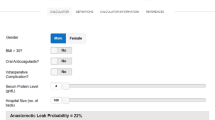Abstract
Background
Anastomotic leak (AL) is a common complication after colectomy with a relatively high failure to rescue rate (FTR), or death after major complications. There is emerging evidence to suggest an early AL may be associated with increased technical difficulty. Whether the timing of an AL is associated with higher FTR has not been established.
Methods
Patients who underwent a colectomy between 2012 and 2017 were identified from the American College of Surgeons National Quality Improvement Program (ACS NSQIP database). The primary outcome was FTR after AL. The predictor variable used was day of post-operative leak (POD) categorized into early (POD ≤ 3), intermediate (3 < POD ≤ 20) and late (20 < POD ≤ 30) AL. These POD groups were compared to generate hypotheses to explain any association observed between timing of AL and FTR.
Results
Of 135,539 identified patients, 4613 patients experienced an AL (3.4%) with an overall FTR of 6.4%. FTR differed by timing of AL: early AL was found to have a FTR of 28/195 (12.6%), with a FTR in intermediate AL of 152/2550 (5.6%) and 3/356 (0.8%) in late AL patients (p < 0.0001). When compared by timing of AL, patients differed by sex, pre-operative bowel preparation, de-functioning ostomy rates and re-operation rates (p < 0.05). Controlling for age, ASA, sex, emergency status, operative approach, indication, de-functioning ostomy, re-operation and concurrent procedure, an early AL was found to have a 2.3-fold increased risk of FTR (95% CI 1.38–3.84, p = 0.001), with a late AL having a 0.15-fold decreased risk (95% CI 0.04–0.49, p = 0.002), both compared to an intermediate AL.
Conclusion
Early ALs, occurring within three days of surgery, may carry a significant risk of FTR. Given the findings identified here, this may support the use of early detection algorithms and interventions of AL to minimize the risk of FTR.


Similar content being viewed by others
References
Sparreboom CL, van Groningen JT, Lingsma HF, Wouters MWJM et al (2018) Different risk factors for early and late colorectal anastomotic leakage in a nationwide audit. Dis Colon Rectum 61(11):1258–1266. https://doi.org/10.1097/DCR.0000000000001202
Frasson M, Granero-Castro P, Ramos Rodríguez JL, Flor-Lorente B (2016) Risk factors for anastomotic leak and postoperative morbidity and mortality after elective right colectomy for cancer: results from a prospective, multicentric study of 1102 patients. Int J Colorectal Dis 31(1):105–114
Tevis SE, Carchman EH, Foley EF, Heise CP et al (2016) Does anastomotic leak contribute to high failure to rescue rates? Ann Surg 263:1148–1151
Hyder JA, Wakeam E, Adler JT, DeBord SA et al (2015) Comparing preoperative targets to failure-to-rescue for surgical mortality improvement. J Am Coll Surg 220(6):1096–1106
Ghaferi AA, Birkmeyer JD, Dimick JB (2009) Variation in hospital mortality associated with inpatient surgery. N Engl J Med 361:1368–1375
Ghaferi AA, Birkmeyer JD, Dimick JB (2009) Complications, failure to rescue, and mortality with major inpatient surgery in Medicare patients. Ann Surg 250:1029–1034
Ghaferi AA, Birkmeyer JD, Dimick JB (2011) Hospital volume and failure to rescue with high-risk surgery. Med Care 49:1076–1081
Ghaferi AA, Dimick JB (2012) Variation in mortality after high-risk cancer surgery: failure to rescue. Surg Oncol Clin North Am 21:389–395
Pasquali SK, He X, Jacobs JP et al (2012) Evaluation of failure to rescue as a quality metric in pediatric heart surgery: an analysis of the STS Congenital Heart Surgery Database. Ann Thorac Surg 94:573–579
Benedetti M, Ciano P, Pergolini I, Ciotti S et al (2019) Early diagnosis of anastomotic leakage after colorectal surgery by the Dutch leakage score, serum procalcitonin and serum C-reactive protein: study protocol of a prospective multicentre observational study by the Italian ColoRectal Anastomotic Leakage Group. G Chir 40(1):20–25
Garcia-Granero A, Frasson M, Flor-Lorente B, Blanco F (2013) Procalcitonin and C-reactive protein as early predictors of anastomotic leak in colorectal surgery: a prospective observational study. Dis Colon Rectum 56(4):475–483. https://doi.org/10.1097/DCR.0b013e31826ce825
ACS NSQIP Participant Use Data File (2019) https://www.facs.org/quality-programs/acsnsqip/participant-use. Accessed 19 Nov 2019
Li Y-W, Lian P, Huang B et al (2017) Very early colorectal anastomotic leakage within 5 post-operative days: a more severe subtype needs relaparotomy. Sci Rep 7:39936. https://doi.org/10.1038/srep39936
Wang XT, Li L, Kong FB et al (2020) Surgical-related risk factors associated with anastomotic leakage after resection for rectal cancer: a meta-analysis. Jpn J Clin Oncol 50(1):20–28
Nikolian VC, Neil SK, Regenbogen SE et al (2017) Anastomotic leak after colorectal resection: a population-based study of risk factors and hospital variation. Surgery 161(6):1619–1627
Jannasch O, Klinge T, Otto R et al (2015) Risk factors, short and long term outcome of anastomotic leaks in rectal cancer. Oncotarget 6(34):36884–36893
Laimi L, Sparreboom CL, Lingsma HF et al (2018) The effect of age on anastomotic leakage in colorectal cancer surgery: a population-based study. J Surg Oncol 118(1):113–120
Floodeen H, Hallböök O, Rutegård J, Sjödahl R et al (2013) Early and late symptomatic anastomotic leakage following low anterior resection of the rectum for cancer: are they different entities? Colorectal Dis 15(3):334–340
Muñoz JL, Alvarez MO, Cuquerella V (2018) Procalcitonin and C-reactive protein as early markers of anastomotic leak after laparoscopic colorectal surgery within an enhanced recovery after surgery (ERAS) program. Surg Endosc 32(9):4003–4010
Author information
Authors and Affiliations
Corresponding author
Ethics declarations
Disclosures
Drs. Spence, Hirpara, Chadi, Quereshy and S. Doshi have no conflicts of interest or financial ties to disclose.
Additional information
Publisher's Note
Springer Nature remains neutral with regard to jurisdictional claims in published maps and institutional affiliations.
Rights and permissions
About this article
Cite this article
Spence, R.T., Hirpara, D.H., Doshi, S. et al. Anastomotic leak after colorectal surgery: does timing affect failure to rescue?. Surg Endosc 36, 771–777 (2022). https://doi.org/10.1007/s00464-020-08270-4
Received:
Accepted:
Published:
Issue Date:
DOI: https://doi.org/10.1007/s00464-020-08270-4




